Video Copyrights: Factors, Registration, and Infringement Report
VerifiedAdded on 2021/06/15
|9
|2227
|494
Report
AI Summary
This report comprehensively examines video copyrights, covering essential aspects for creators and users. It begins with an introduction to video copyrights, defining them as the exclusive rights granted to video creators, preventing unauthorized copying or distribution. The report delves into crucial factors to consider when copyrighting a video, including releases, recording locations, legal audio, and the use of stills and images, emphasizing the importance of obtaining permissions and adhering to privacy laws. It outlines the process of copyright registration through the Electronic Copyright Office, detailing the necessary steps for securing exclusive rights. The report also discusses the duration of copyrights, public domain works, and public licensed works, such as those found on platforms like YouTube. Furthermore, it clarifies the rights of copyright holders, encompassing copying, distribution, reproduction, display, and modification, while also highlighting the rights of users, including fair use and educational purposes. The report concludes by addressing copyright infringement, its consequences, and the importance of adhering to copyright laws to avoid legal repercussions. The report references various scholarly sources to support its claims and provides a well-rounded understanding of video copyrights.
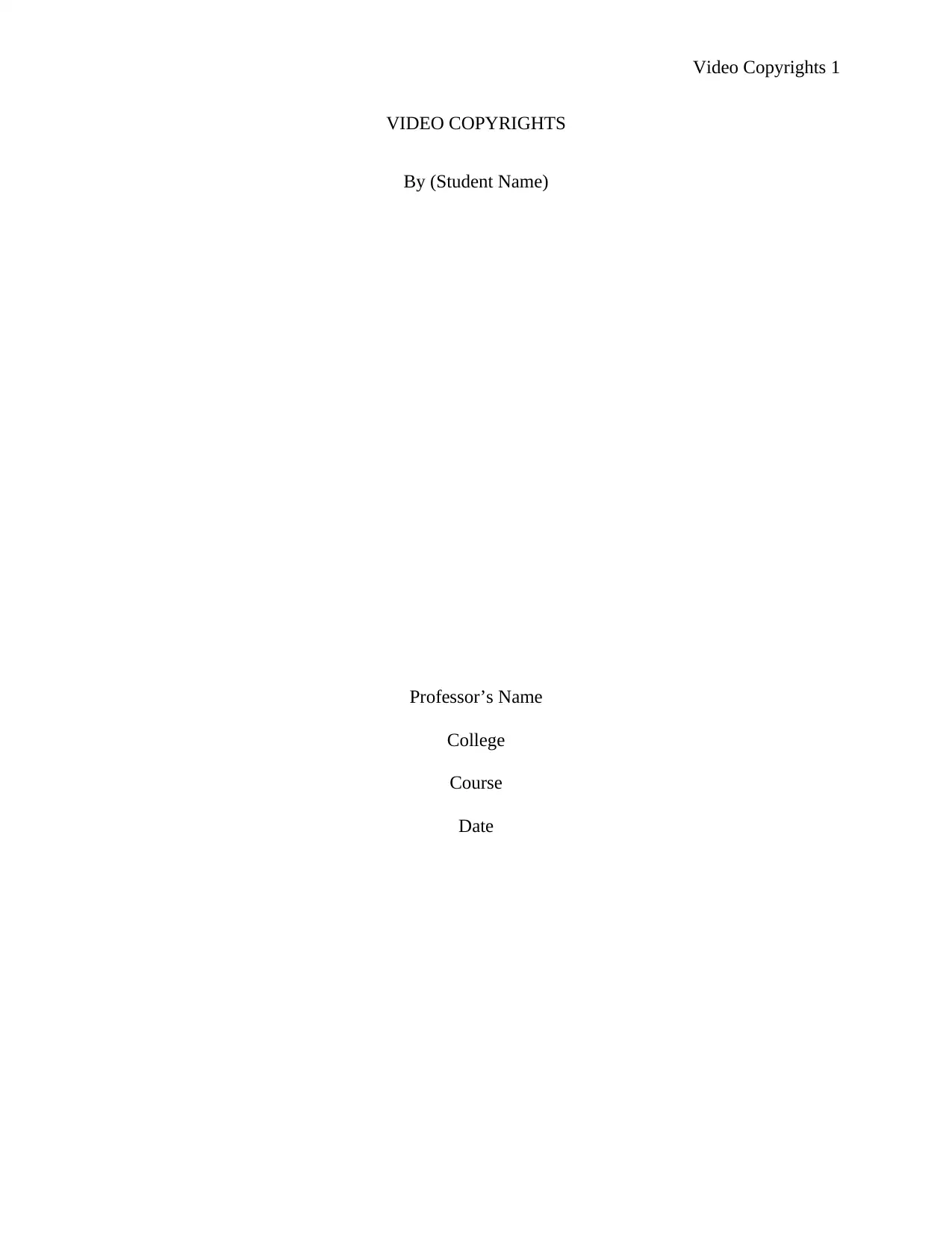
Video Copyrights 1
VIDEO COPYRIGHTS
By (Student Name)
Professor’s Name
College
Course
Date
VIDEO COPYRIGHTS
By (Student Name)
Professor’s Name
College
Course
Date
Paraphrase This Document
Need a fresh take? Get an instant paraphrase of this document with our AI Paraphraser
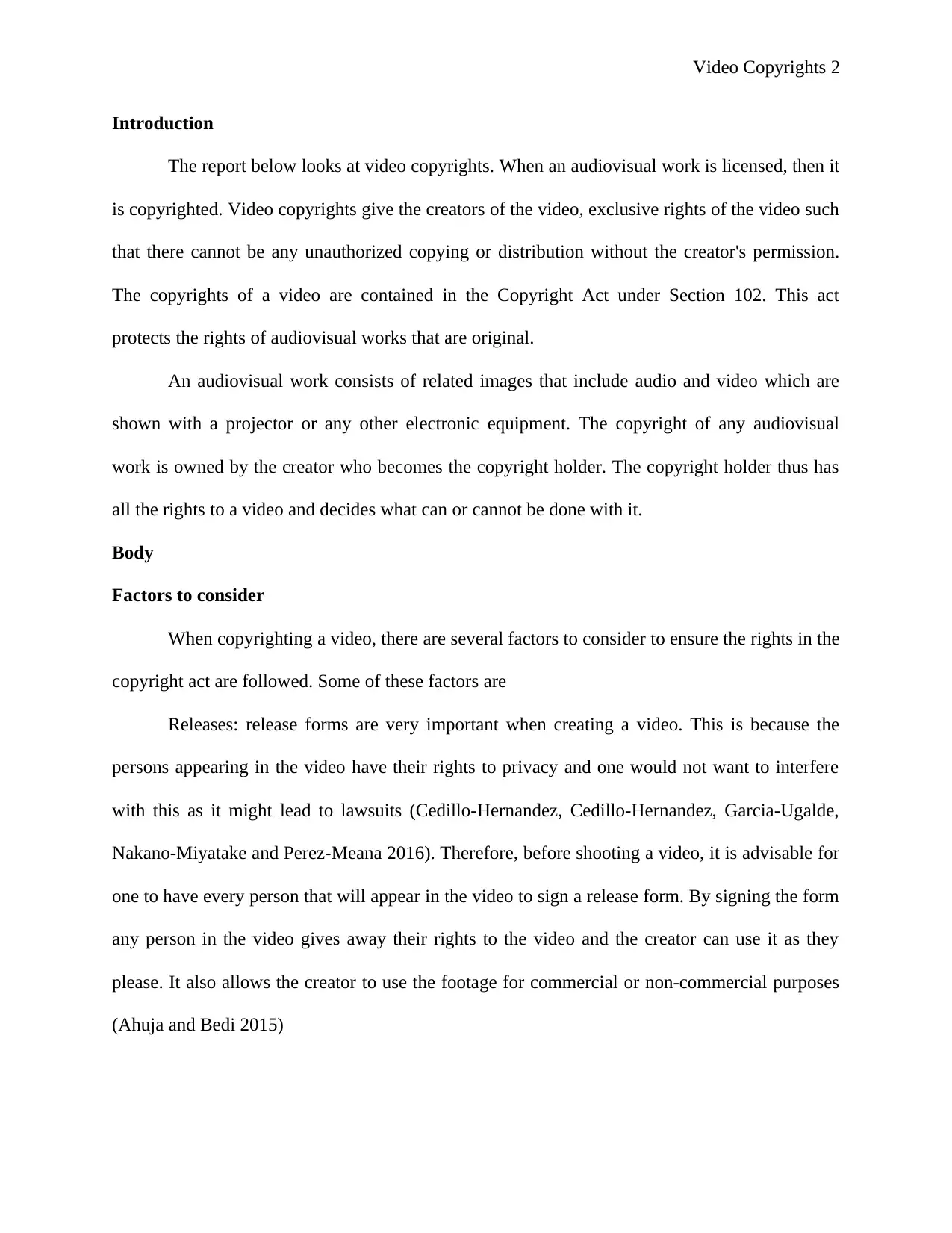
Video Copyrights 2
Introduction
The report below looks at video copyrights. When an audiovisual work is licensed, then it
is copyrighted. Video copyrights give the creators of the video, exclusive rights of the video such
that there cannot be any unauthorized copying or distribution without the creator's permission.
The copyrights of a video are contained in the Copyright Act under Section 102. This act
protects the rights of audiovisual works that are original.
An audiovisual work consists of related images that include audio and video which are
shown with a projector or any other electronic equipment. The copyright of any audiovisual
work is owned by the creator who becomes the copyright holder. The copyright holder thus has
all the rights to a video and decides what can or cannot be done with it.
Body
Factors to consider
When copyrighting a video, there are several factors to consider to ensure the rights in the
copyright act are followed. Some of these factors are
Releases: release forms are very important when creating a video. This is because the
persons appearing in the video have their rights to privacy and one would not want to interfere
with this as it might lead to lawsuits (Cedillo-Hernandez, Cedillo-Hernandez, Garcia-Ugalde,
Nakano-Miyatake and Perez-Meana 2016). Therefore, before shooting a video, it is advisable for
one to have every person that will appear in the video to sign a release form. By signing the form
any person in the video gives away their rights to the video and the creator can use it as they
please. It also allows the creator to use the footage for commercial or non-commercial purposes
(Ahuja and Bedi 2015)
Introduction
The report below looks at video copyrights. When an audiovisual work is licensed, then it
is copyrighted. Video copyrights give the creators of the video, exclusive rights of the video such
that there cannot be any unauthorized copying or distribution without the creator's permission.
The copyrights of a video are contained in the Copyright Act under Section 102. This act
protects the rights of audiovisual works that are original.
An audiovisual work consists of related images that include audio and video which are
shown with a projector or any other electronic equipment. The copyright of any audiovisual
work is owned by the creator who becomes the copyright holder. The copyright holder thus has
all the rights to a video and decides what can or cannot be done with it.
Body
Factors to consider
When copyrighting a video, there are several factors to consider to ensure the rights in the
copyright act are followed. Some of these factors are
Releases: release forms are very important when creating a video. This is because the
persons appearing in the video have their rights to privacy and one would not want to interfere
with this as it might lead to lawsuits (Cedillo-Hernandez, Cedillo-Hernandez, Garcia-Ugalde,
Nakano-Miyatake and Perez-Meana 2016). Therefore, before shooting a video, it is advisable for
one to have every person that will appear in the video to sign a release form. By signing the form
any person in the video gives away their rights to the video and the creator can use it as they
please. It also allows the creator to use the footage for commercial or non-commercial purposes
(Ahuja and Bedi 2015)
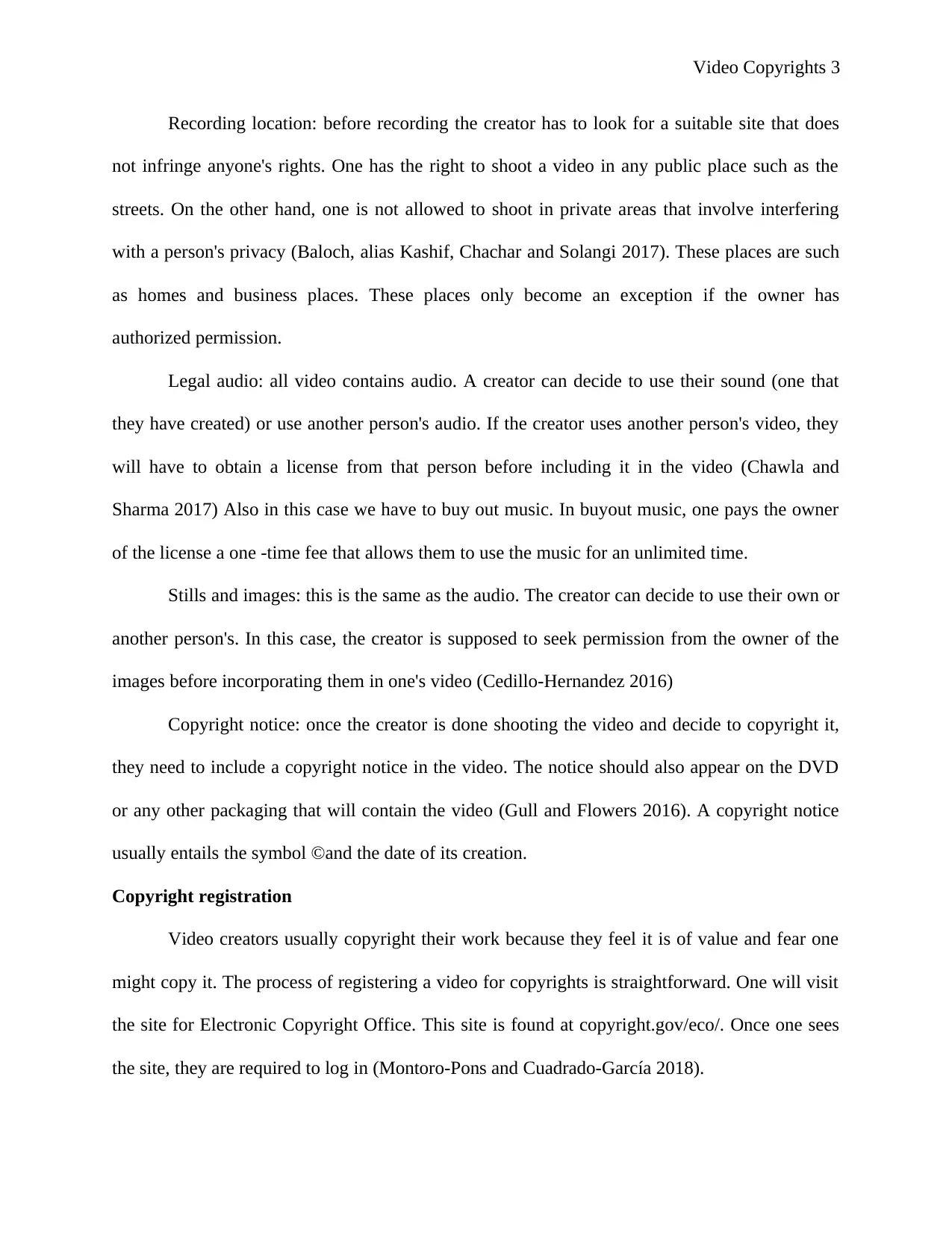
Video Copyrights 3
Recording location: before recording the creator has to look for a suitable site that does
not infringe anyone's rights. One has the right to shoot a video in any public place such as the
streets. On the other hand, one is not allowed to shoot in private areas that involve interfering
with a person's privacy (Baloch, alias Kashif, Chachar and Solangi 2017). These places are such
as homes and business places. These places only become an exception if the owner has
authorized permission.
Legal audio: all video contains audio. A creator can decide to use their sound (one that
they have created) or use another person's audio. If the creator uses another person's video, they
will have to obtain a license from that person before including it in the video (Chawla and
Sharma 2017) Also in this case we have to buy out music. In buyout music, one pays the owner
of the license a one -time fee that allows them to use the music for an unlimited time.
Stills and images: this is the same as the audio. The creator can decide to use their own or
another person's. In this case, the creator is supposed to seek permission from the owner of the
images before incorporating them in one's video (Cedillo-Hernandez 2016)
Copyright notice: once the creator is done shooting the video and decide to copyright it,
they need to include a copyright notice in the video. The notice should also appear on the DVD
or any other packaging that will contain the video (Gull and Flowers 2016). A copyright notice
usually entails the symbol ©and the date of its creation.
Copyright registration
Video creators usually copyright their work because they feel it is of value and fear one
might copy it. The process of registering a video for copyrights is straightforward. One will visit
the site for Electronic Copyright Office. This site is found at copyright.gov/eco/. Once one sees
the site, they are required to log in (Montoro-Pons and Cuadrado-García 2018).
Recording location: before recording the creator has to look for a suitable site that does
not infringe anyone's rights. One has the right to shoot a video in any public place such as the
streets. On the other hand, one is not allowed to shoot in private areas that involve interfering
with a person's privacy (Baloch, alias Kashif, Chachar and Solangi 2017). These places are such
as homes and business places. These places only become an exception if the owner has
authorized permission.
Legal audio: all video contains audio. A creator can decide to use their sound (one that
they have created) or use another person's audio. If the creator uses another person's video, they
will have to obtain a license from that person before including it in the video (Chawla and
Sharma 2017) Also in this case we have to buy out music. In buyout music, one pays the owner
of the license a one -time fee that allows them to use the music for an unlimited time.
Stills and images: this is the same as the audio. The creator can decide to use their own or
another person's. In this case, the creator is supposed to seek permission from the owner of the
images before incorporating them in one's video (Cedillo-Hernandez 2016)
Copyright notice: once the creator is done shooting the video and decide to copyright it,
they need to include a copyright notice in the video. The notice should also appear on the DVD
or any other packaging that will contain the video (Gull and Flowers 2016). A copyright notice
usually entails the symbol ©and the date of its creation.
Copyright registration
Video creators usually copyright their work because they feel it is of value and fear one
might copy it. The process of registering a video for copyrights is straightforward. One will visit
the site for Electronic Copyright Office. This site is found at copyright.gov/eco/. Once one sees
the site, they are required to log in (Montoro-Pons and Cuadrado-García 2018).
⊘ This is a preview!⊘
Do you want full access?
Subscribe today to unlock all pages.

Trusted by 1+ million students worldwide
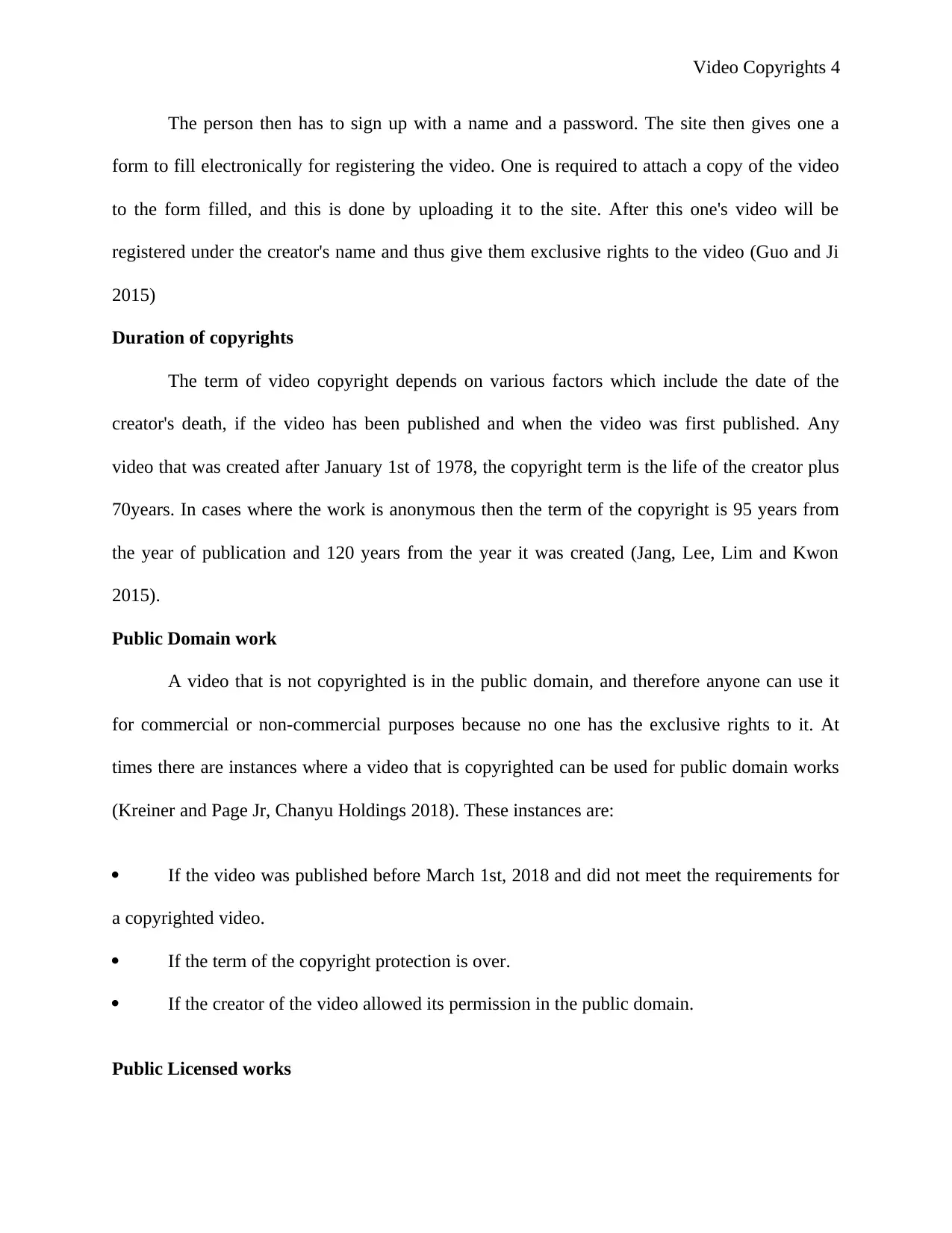
Video Copyrights 4
The person then has to sign up with a name and a password. The site then gives one a
form to fill electronically for registering the video. One is required to attach a copy of the video
to the form filled, and this is done by uploading it to the site. After this one's video will be
registered under the creator's name and thus give them exclusive rights to the video (Guo and Ji
2015)
Duration of copyrights
The term of video copyright depends on various factors which include the date of the
creator's death, if the video has been published and when the video was first published. Any
video that was created after January 1st of 1978, the copyright term is the life of the creator plus
70years. In cases where the work is anonymous then the term of the copyright is 95 years from
the year of publication and 120 years from the year it was created (Jang, Lee, Lim and Kwon
2015).
Public Domain work
A video that is not copyrighted is in the public domain, and therefore anyone can use it
for commercial or non-commercial purposes because no one has the exclusive rights to it. At
times there are instances where a video that is copyrighted can be used for public domain works
(Kreiner and Page Jr, Chanyu Holdings 2018). These instances are:
If the video was published before March 1st, 2018 and did not meet the requirements for
a copyrighted video.
If the term of the copyright protection is over.
If the creator of the video allowed its permission in the public domain.
Public Licensed works
The person then has to sign up with a name and a password. The site then gives one a
form to fill electronically for registering the video. One is required to attach a copy of the video
to the form filled, and this is done by uploading it to the site. After this one's video will be
registered under the creator's name and thus give them exclusive rights to the video (Guo and Ji
2015)
Duration of copyrights
The term of video copyright depends on various factors which include the date of the
creator's death, if the video has been published and when the video was first published. Any
video that was created after January 1st of 1978, the copyright term is the life of the creator plus
70years. In cases where the work is anonymous then the term of the copyright is 95 years from
the year of publication and 120 years from the year it was created (Jang, Lee, Lim and Kwon
2015).
Public Domain work
A video that is not copyrighted is in the public domain, and therefore anyone can use it
for commercial or non-commercial purposes because no one has the exclusive rights to it. At
times there are instances where a video that is copyrighted can be used for public domain works
(Kreiner and Page Jr, Chanyu Holdings 2018). These instances are:
If the video was published before March 1st, 2018 and did not meet the requirements for
a copyrighted video.
If the term of the copyright protection is over.
If the creator of the video allowed its permission in the public domain.
Public Licensed works
Paraphrase This Document
Need a fresh take? Get an instant paraphrase of this document with our AI Paraphraser
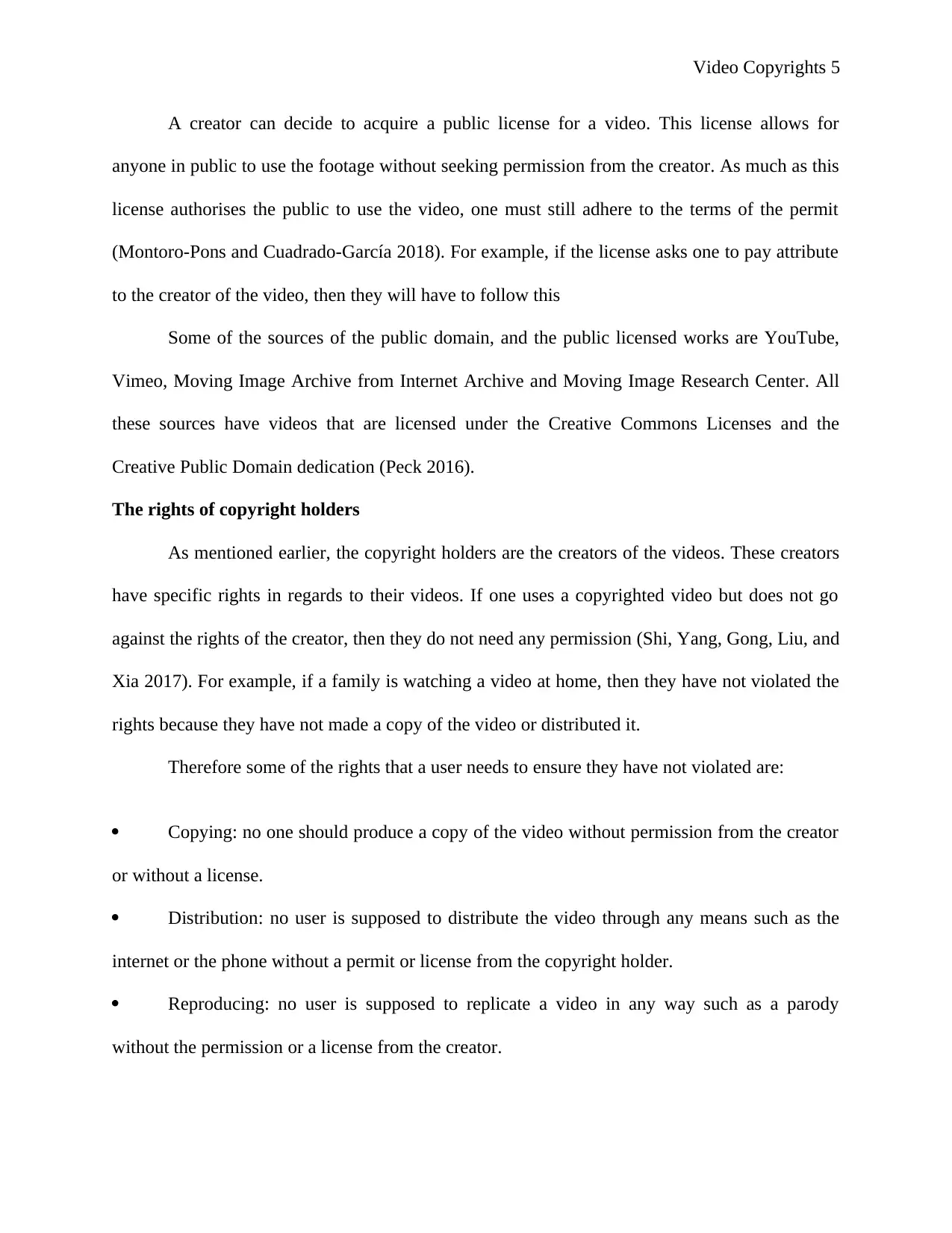
Video Copyrights 5
A creator can decide to acquire a public license for a video. This license allows for
anyone in public to use the footage without seeking permission from the creator. As much as this
license authorises the public to use the video, one must still adhere to the terms of the permit
(Montoro-Pons and Cuadrado-García 2018). For example, if the license asks one to pay attribute
to the creator of the video, then they will have to follow this
Some of the sources of the public domain, and the public licensed works are YouTube,
Vimeo, Moving Image Archive from Internet Archive and Moving Image Research Center. All
these sources have videos that are licensed under the Creative Commons Licenses and the
Creative Public Domain dedication (Peck 2016).
The rights of copyright holders
As mentioned earlier, the copyright holders are the creators of the videos. These creators
have specific rights in regards to their videos. If one uses a copyrighted video but does not go
against the rights of the creator, then they do not need any permission (Shi, Yang, Gong, Liu, and
Xia 2017). For example, if a family is watching a video at home, then they have not violated the
rights because they have not made a copy of the video or distributed it.
Therefore some of the rights that a user needs to ensure they have not violated are:
Copying: no one should produce a copy of the video without permission from the creator
or without a license.
Distribution: no user is supposed to distribute the video through any means such as the
internet or the phone without a permit or license from the copyright holder.
Reproducing: no user is supposed to replicate a video in any way such as a parody
without the permission or a license from the creator.
A creator can decide to acquire a public license for a video. This license allows for
anyone in public to use the footage without seeking permission from the creator. As much as this
license authorises the public to use the video, one must still adhere to the terms of the permit
(Montoro-Pons and Cuadrado-García 2018). For example, if the license asks one to pay attribute
to the creator of the video, then they will have to follow this
Some of the sources of the public domain, and the public licensed works are YouTube,
Vimeo, Moving Image Archive from Internet Archive and Moving Image Research Center. All
these sources have videos that are licensed under the Creative Commons Licenses and the
Creative Public Domain dedication (Peck 2016).
The rights of copyright holders
As mentioned earlier, the copyright holders are the creators of the videos. These creators
have specific rights in regards to their videos. If one uses a copyrighted video but does not go
against the rights of the creator, then they do not need any permission (Shi, Yang, Gong, Liu, and
Xia 2017). For example, if a family is watching a video at home, then they have not violated the
rights because they have not made a copy of the video or distributed it.
Therefore some of the rights that a user needs to ensure they have not violated are:
Copying: no one should produce a copy of the video without permission from the creator
or without a license.
Distribution: no user is supposed to distribute the video through any means such as the
internet or the phone without a permit or license from the copyright holder.
Reproducing: no user is supposed to replicate a video in any way such as a parody
without the permission or a license from the creator.
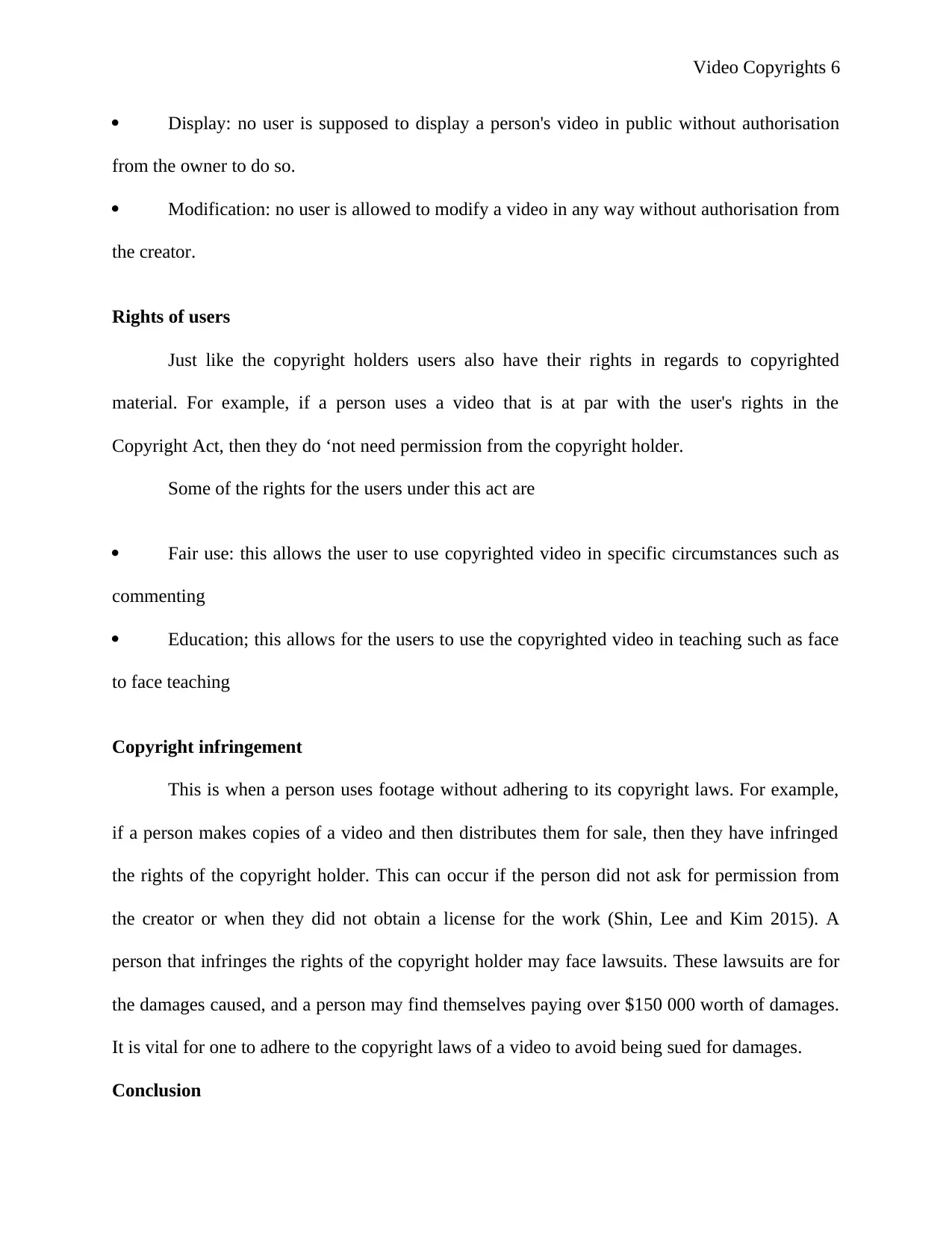
Video Copyrights 6
Display: no user is supposed to display a person's video in public without authorisation
from the owner to do so.
Modification: no user is allowed to modify a video in any way without authorisation from
the creator.
Rights of users
Just like the copyright holders users also have their rights in regards to copyrighted
material. For example, if a person uses a video that is at par with the user's rights in the
Copyright Act, then they do ‘not need permission from the copyright holder.
Some of the rights for the users under this act are
Fair use: this allows the user to use copyrighted video in specific circumstances such as
commenting
Education; this allows for the users to use the copyrighted video in teaching such as face
to face teaching
Copyright infringement
This is when a person uses footage without adhering to its copyright laws. For example,
if a person makes copies of a video and then distributes them for sale, then they have infringed
the rights of the copyright holder. This can occur if the person did not ask for permission from
the creator or when they did not obtain a license for the work (Shin, Lee and Kim 2015). A
person that infringes the rights of the copyright holder may face lawsuits. These lawsuits are for
the damages caused, and a person may find themselves paying over $150 000 worth of damages.
It is vital for one to adhere to the copyright laws of a video to avoid being sued for damages.
Conclusion
Display: no user is supposed to display a person's video in public without authorisation
from the owner to do so.
Modification: no user is allowed to modify a video in any way without authorisation from
the creator.
Rights of users
Just like the copyright holders users also have their rights in regards to copyrighted
material. For example, if a person uses a video that is at par with the user's rights in the
Copyright Act, then they do ‘not need permission from the copyright holder.
Some of the rights for the users under this act are
Fair use: this allows the user to use copyrighted video in specific circumstances such as
commenting
Education; this allows for the users to use the copyrighted video in teaching such as face
to face teaching
Copyright infringement
This is when a person uses footage without adhering to its copyright laws. For example,
if a person makes copies of a video and then distributes them for sale, then they have infringed
the rights of the copyright holder. This can occur if the person did not ask for permission from
the creator or when they did not obtain a license for the work (Shin, Lee and Kim 2015). A
person that infringes the rights of the copyright holder may face lawsuits. These lawsuits are for
the damages caused, and a person may find themselves paying over $150 000 worth of damages.
It is vital for one to adhere to the copyright laws of a video to avoid being sued for damages.
Conclusion
⊘ This is a preview!⊘
Do you want full access?
Subscribe today to unlock all pages.

Trusted by 1+ million students worldwide
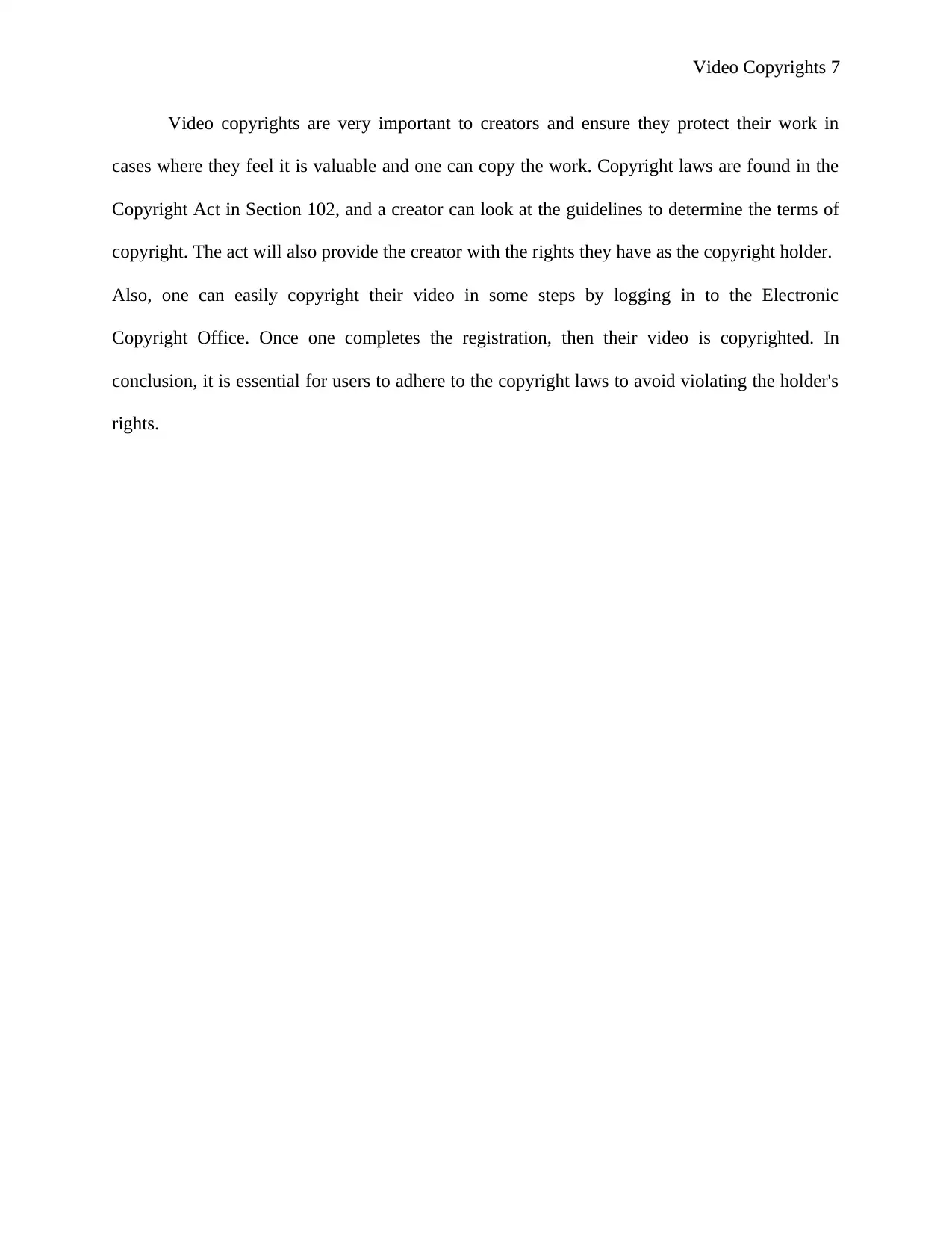
Video Copyrights 7
Video copyrights are very important to creators and ensure they protect their work in
cases where they feel it is valuable and one can copy the work. Copyright laws are found in the
Copyright Act in Section 102, and a creator can look at the guidelines to determine the terms of
copyright. The act will also provide the creator with the rights they have as the copyright holder.
Also, one can easily copyright their video in some steps by logging in to the Electronic
Copyright Office. Once one completes the registration, then their video is copyrighted. In
conclusion, it is essential for users to adhere to the copyright laws to avoid violating the holder's
rights.
Video copyrights are very important to creators and ensure they protect their work in
cases where they feel it is valuable and one can copy the work. Copyright laws are found in the
Copyright Act in Section 102, and a creator can look at the guidelines to determine the terms of
copyright. The act will also provide the creator with the rights they have as the copyright holder.
Also, one can easily copyright their video in some steps by logging in to the Electronic
Copyright Office. Once one completes the registration, then their video is copyrighted. In
conclusion, it is essential for users to adhere to the copyright laws to avoid violating the holder's
rights.
Paraphrase This Document
Need a fresh take? Get an instant paraphrase of this document with our AI Paraphraser
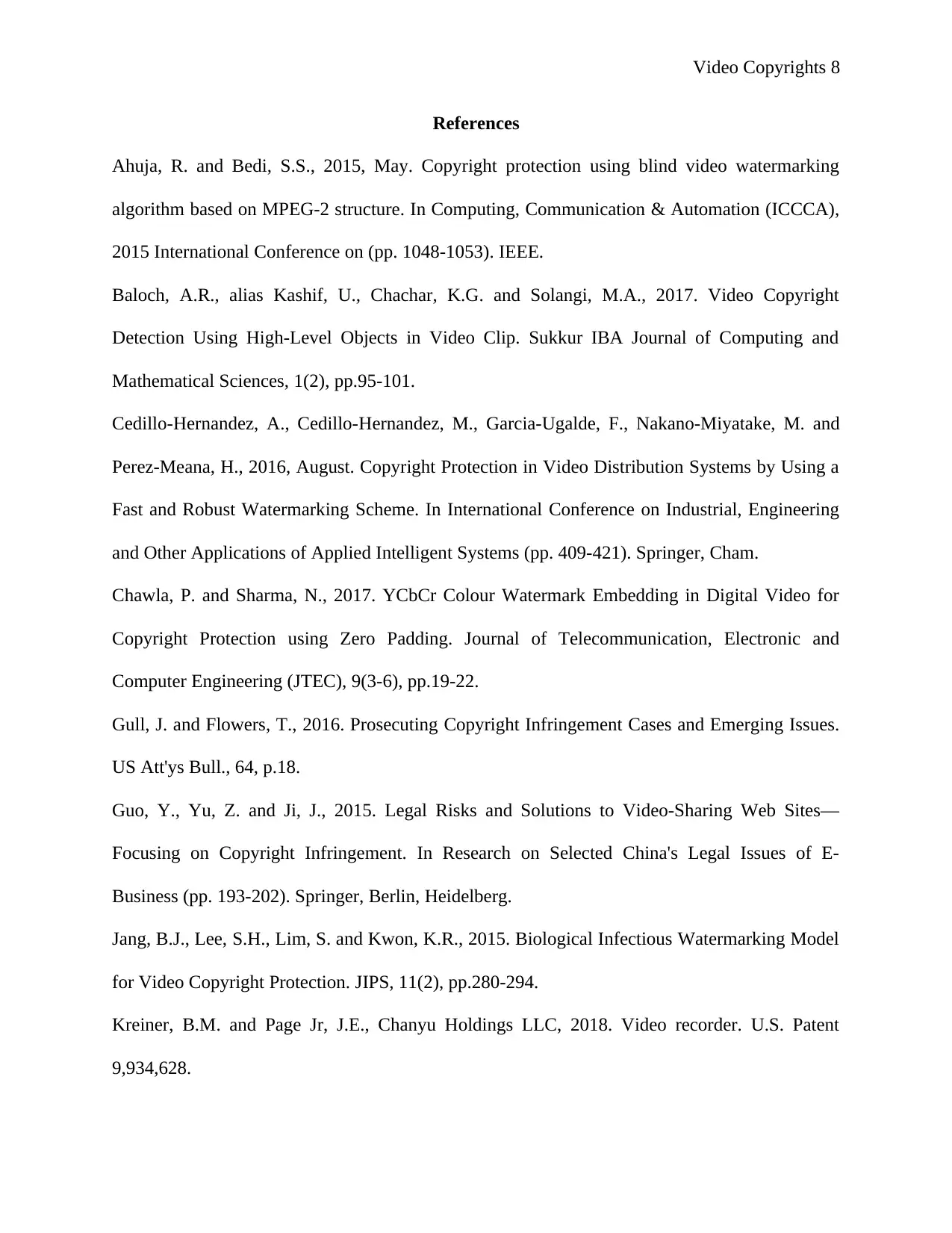
Video Copyrights 8
References
Ahuja, R. and Bedi, S.S., 2015, May. Copyright protection using blind video watermarking
algorithm based on MPEG-2 structure. In Computing, Communication & Automation (ICCCA),
2015 International Conference on (pp. 1048-1053). IEEE.
Baloch, A.R., alias Kashif, U., Chachar, K.G. and Solangi, M.A., 2017. Video Copyright
Detection Using High-Level Objects in Video Clip. Sukkur IBA Journal of Computing and
Mathematical Sciences, 1(2), pp.95-101.
Cedillo-Hernandez, A., Cedillo-Hernandez, M., Garcia-Ugalde, F., Nakano-Miyatake, M. and
Perez-Meana, H., 2016, August. Copyright Protection in Video Distribution Systems by Using a
Fast and Robust Watermarking Scheme. In International Conference on Industrial, Engineering
and Other Applications of Applied Intelligent Systems (pp. 409-421). Springer, Cham.
Chawla, P. and Sharma, N., 2017. YCbCr Colour Watermark Embedding in Digital Video for
Copyright Protection using Zero Padding. Journal of Telecommunication, Electronic and
Computer Engineering (JTEC), 9(3-6), pp.19-22.
Gull, J. and Flowers, T., 2016. Prosecuting Copyright Infringement Cases and Emerging Issues.
US Att'ys Bull., 64, p.18.
Guo, Y., Yu, Z. and Ji, J., 2015. Legal Risks and Solutions to Video-Sharing Web Sites—
Focusing on Copyright Infringement. In Research on Selected China's Legal Issues of E-
Business (pp. 193-202). Springer, Berlin, Heidelberg.
Jang, B.J., Lee, S.H., Lim, S. and Kwon, K.R., 2015. Biological Infectious Watermarking Model
for Video Copyright Protection. JIPS, 11(2), pp.280-294.
Kreiner, B.M. and Page Jr, J.E., Chanyu Holdings LLC, 2018. Video recorder. U.S. Patent
9,934,628.
References
Ahuja, R. and Bedi, S.S., 2015, May. Copyright protection using blind video watermarking
algorithm based on MPEG-2 structure. In Computing, Communication & Automation (ICCCA),
2015 International Conference on (pp. 1048-1053). IEEE.
Baloch, A.R., alias Kashif, U., Chachar, K.G. and Solangi, M.A., 2017. Video Copyright
Detection Using High-Level Objects in Video Clip. Sukkur IBA Journal of Computing and
Mathematical Sciences, 1(2), pp.95-101.
Cedillo-Hernandez, A., Cedillo-Hernandez, M., Garcia-Ugalde, F., Nakano-Miyatake, M. and
Perez-Meana, H., 2016, August. Copyright Protection in Video Distribution Systems by Using a
Fast and Robust Watermarking Scheme. In International Conference on Industrial, Engineering
and Other Applications of Applied Intelligent Systems (pp. 409-421). Springer, Cham.
Chawla, P. and Sharma, N., 2017. YCbCr Colour Watermark Embedding in Digital Video for
Copyright Protection using Zero Padding. Journal of Telecommunication, Electronic and
Computer Engineering (JTEC), 9(3-6), pp.19-22.
Gull, J. and Flowers, T., 2016. Prosecuting Copyright Infringement Cases and Emerging Issues.
US Att'ys Bull., 64, p.18.
Guo, Y., Yu, Z. and Ji, J., 2015. Legal Risks and Solutions to Video-Sharing Web Sites—
Focusing on Copyright Infringement. In Research on Selected China's Legal Issues of E-
Business (pp. 193-202). Springer, Berlin, Heidelberg.
Jang, B.J., Lee, S.H., Lim, S. and Kwon, K.R., 2015. Biological Infectious Watermarking Model
for Video Copyright Protection. JIPS, 11(2), pp.280-294.
Kreiner, B.M. and Page Jr, J.E., Chanyu Holdings LLC, 2018. Video recorder. U.S. Patent
9,934,628.
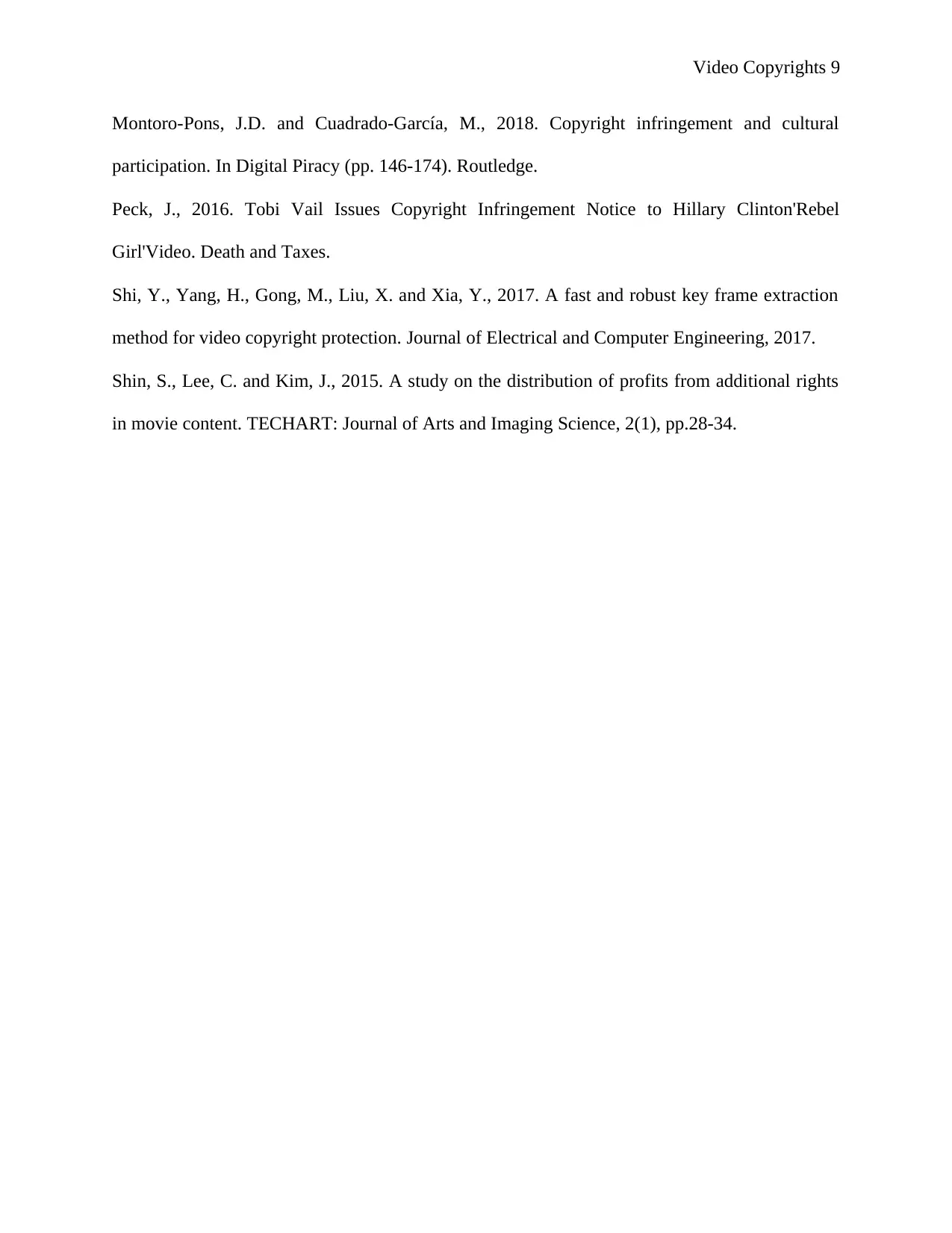
Video Copyrights 9
Montoro-Pons, J.D. and Cuadrado-García, M., 2018. Copyright infringement and cultural
participation. In Digital Piracy (pp. 146-174). Routledge.
Peck, J., 2016. Tobi Vail Issues Copyright Infringement Notice to Hillary Clinton'Rebel
Girl'Video. Death and Taxes.
Shi, Y., Yang, H., Gong, M., Liu, X. and Xia, Y., 2017. A fast and robust key frame extraction
method for video copyright protection. Journal of Electrical and Computer Engineering, 2017.
Shin, S., Lee, C. and Kim, J., 2015. A study on the distribution of profits from additional rights
in movie content. TECHART: Journal of Arts and Imaging Science, 2(1), pp.28-34.
Montoro-Pons, J.D. and Cuadrado-García, M., 2018. Copyright infringement and cultural
participation. In Digital Piracy (pp. 146-174). Routledge.
Peck, J., 2016. Tobi Vail Issues Copyright Infringement Notice to Hillary Clinton'Rebel
Girl'Video. Death and Taxes.
Shi, Y., Yang, H., Gong, M., Liu, X. and Xia, Y., 2017. A fast and robust key frame extraction
method for video copyright protection. Journal of Electrical and Computer Engineering, 2017.
Shin, S., Lee, C. and Kim, J., 2015. A study on the distribution of profits from additional rights
in movie content. TECHART: Journal of Arts and Imaging Science, 2(1), pp.28-34.
⊘ This is a preview!⊘
Do you want full access?
Subscribe today to unlock all pages.

Trusted by 1+ million students worldwide
1 out of 9
Related Documents
Your All-in-One AI-Powered Toolkit for Academic Success.
+13062052269
info@desklib.com
Available 24*7 on WhatsApp / Email
![[object Object]](/_next/static/media/star-bottom.7253800d.svg)
Unlock your academic potential
Copyright © 2020–2025 A2Z Services. All Rights Reserved. Developed and managed by ZUCOL.





